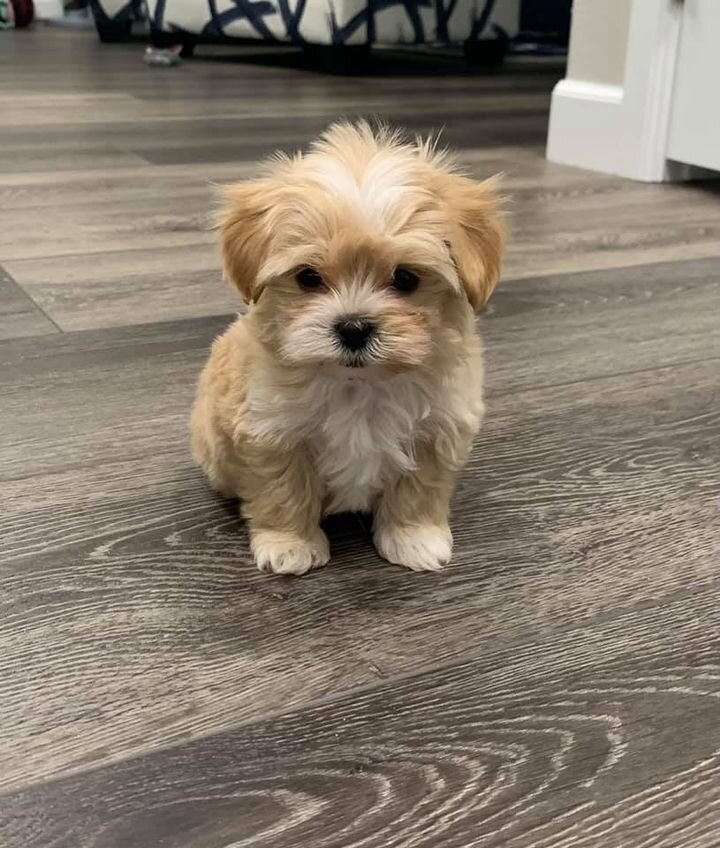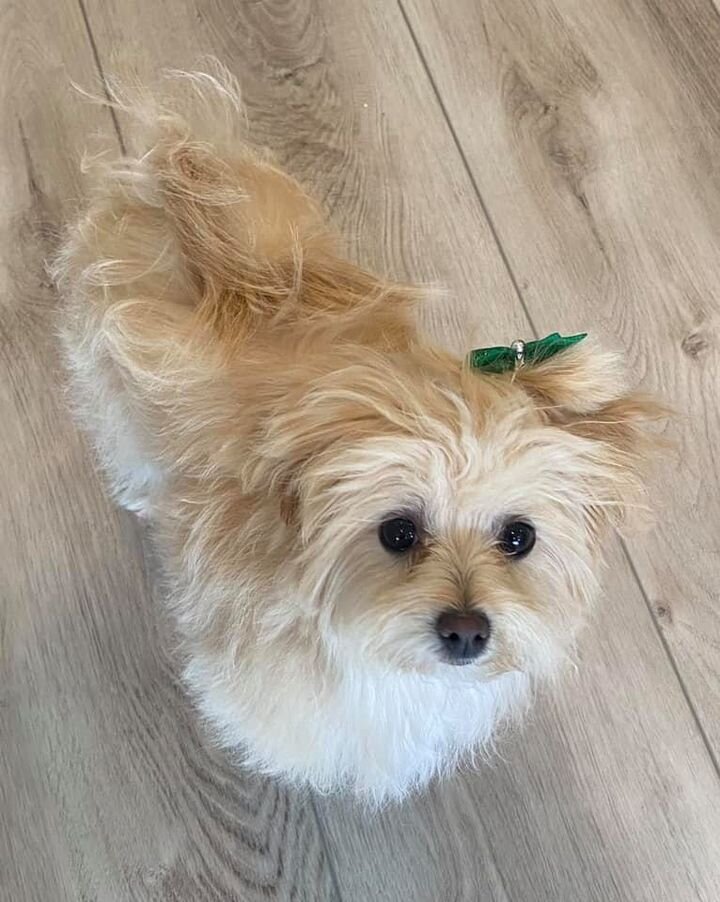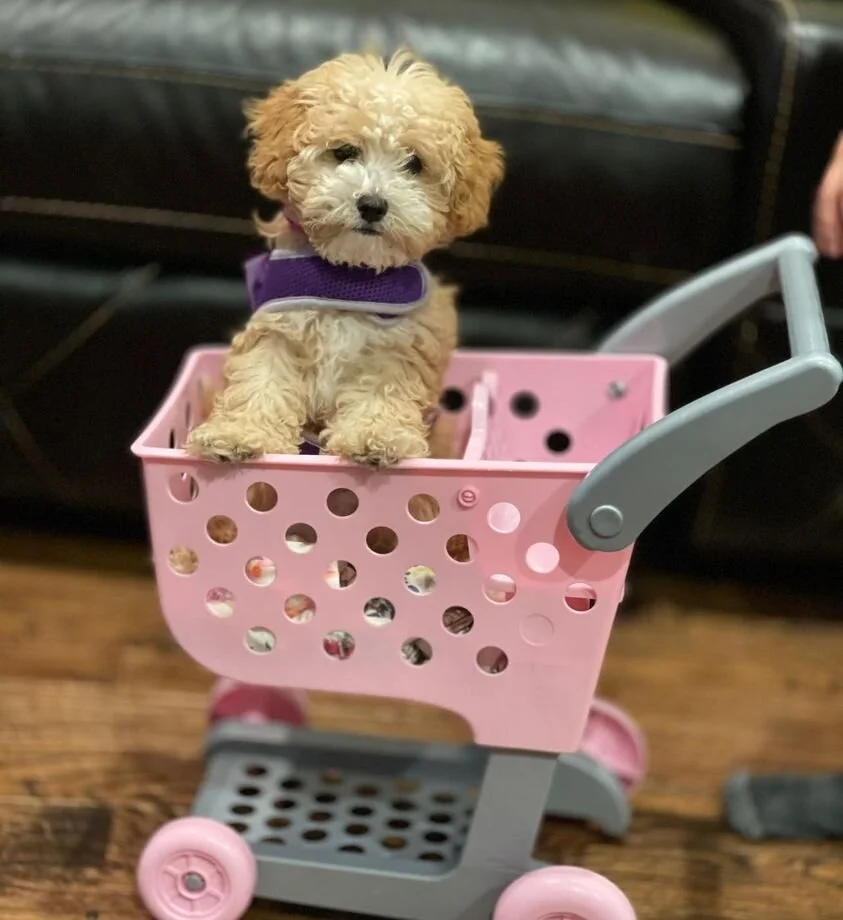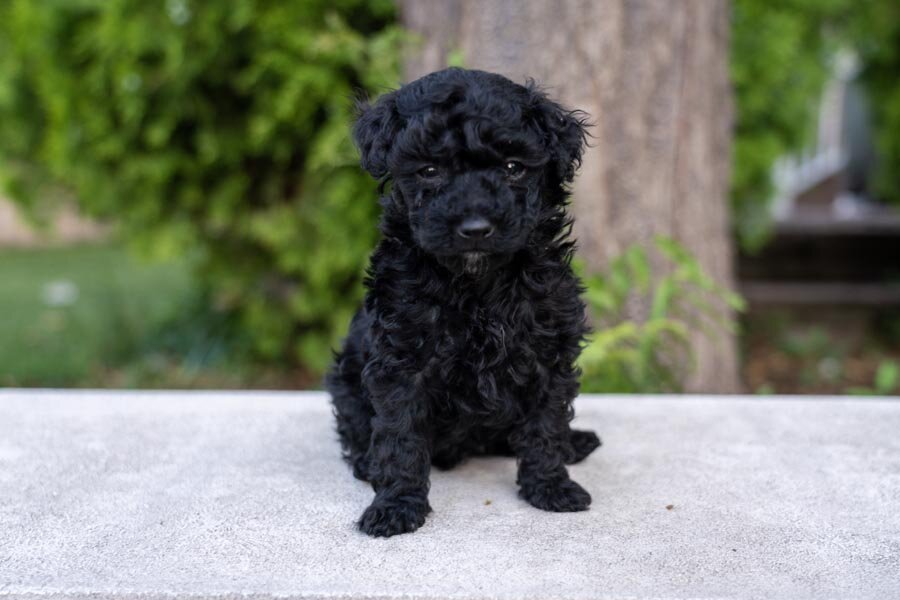
Black & White Maltipoo (Pictures Included)
The Black and White Color is more rare to find on Maltipoos and can give maltipoos a really creative look. The black and white can range from many spots to a more simple two toned look.
The gallery below includes Maltipoo pictures submitted by our Maltipoo Facebook group members. If you want to learn more about Maltipoos and get advice from thousands of Maltipoo owners around the world, be sure to check out our group.
Cream Maltipoo (Pictures included)
Cream is among the most popular color for Maltipoos alongside Red and Apricot. The light cream color and sometimes appear white and you may find lighter or darker patches or blends on cream colored Maltipoos.
Cream is among the most popular and sought after color for Maltipoos, along with Red and Apricot. The lighter cream color can sometimes appear to be white and may also have patches or blends of lighter or darker colors.
The gallery below are not necessarily Maltipoos from our program but were submitted by their owners in our Maltipoos Facebook group. This group includes over 3,000+ members that share very helpful information about the Maltipoo breed and how to care for your Maltipoo.
Apricot Maltipoo (with Pictures included)
Apricot is among the most sought after colors for Maltipoos along with Cream and red. The apricot color can come in many shades in between cream and red and can sometimes have white or lighter patches or blends.
As you can see in the gallery below, the apricot coat (like any other color)can vary from straight, wavy, or curly in texture depending on their parents. These images are not necessarily pictures of puppies in our program but were submitted by their owners in our Maltipoo Facebook group. If you want to become a part of the best Maltipoo group in the nation, be sure to check it out.
White Maltipoo (with pictures)
Want to learn more about the White Maltipoo appearance? This article includes a gallery of many maltipoos submitted by their owners in our Maltipoos Facebook group.
White is among the most common color for Maltipoos that is because of the white color of the Maltese and one of the most common colors of poodles being white as well (although poodles have many color varieties). The white coat on a maltipoo is very gorgeous but for apparent reasons, can be prone to stains such as tear stains on the muzzle and feet stains from playing outside. A good level of care and maintenance is required to keep a white coat shiny. Learn more about keeping your maltipoos eyes clean.
The gallery below are pictures of white maltipoos by their owners in our Maltipoo Facebook Group and are not necessarily dogs from our breeding program. Be sure to visit and join if you’d like to become a part of the best Maltipoo group on the planet and learn from other Maltipoo owners!
Maltipoo Colors
Maltipoos come in a variety of colors from solid black, brown, red, apricot colors to multi colored like Parti or Merl. To see examples of different colors we have gotten from our past litters, scroll down and view the gallery grouped by different Maltipoo Colors
Cream Maltipoos
Apricot Maltipoos
White Maltipoos
Brown Maltipoos
Parti Maltipoos
Black Maltipoos
Merle Maltipoos
Maltese vs. Maltipoo
Let’s start with the obvious. The Maltese is a purebred dog and the Maltipoo is a hybrid dog. In order for a dog to be considered 'purebred' he must be a descendant of known purebreds of the same breed. Most purebred dogs are registered with a kennel club, but it is not required. The clubs were created to keep a guideline that dictates the expected size of the dog, coloring, ear set, tail set etc.. This helps keep a consistent appearance within the breed.
How does a Maltipoo Compare to a Maltese?
Let’s start with the obvious. The Maltese is a purebred dog and the Maltipoo is a hybrid dog. In order for a dog to be considered 'purebred' he must be a descendant of known purebreds of the same breed. Most purebred dogs are registered with a kennel club, but it is not required. The clubs were created to keep a guideline that dictates the expected size of the dog, coloring, ear set, tail set etc.. This helps keep a consistent appearance within the breed.
The Maltese has been around for about 2,800 years and has had the same appearance for most of that time. We know this from the Ancient Greek ceramic artwork.
The Maltipoo is a crossbreed and has no history and no consistency of size, coat, color or temperament. This should not prevent you from falling in love with the Maltipoo. They are generally very smart, friendly dogs that love to cuddle. The Maltipoo lifespan also tends to be long because of their smaller size.
Face Shape Comparison
You will find that most Maltipoos have a muzzle similar to the Maltese.
Poodles have long, narrow snouts.
Maltese have moderate snouts. The skull is 'slightly rounded' and ears are drop ears (they hang by the side of the face) and set low (the base is on the side of the head, not on top).
Since many Maltipoo dogs have these same facial structures, it's easy to see the Maltese influence.
Differences in Coat
Maltipoos can inherit their coat type from either their Maltese parent or their Poodle parent. You might get a silky coat like the Maltese, a tightly curled and frizzled poodle coat or a coat that combines these traits.
Both the Maltese and Poodle are single coated breeds. However, the Maltese hair is usually soft and silky and can be wavy or straight depending on the length of the hair. The Poodle hair is dense, curly and somewhat water resistant.
Maltipoos, on the other hand, have both Maltese and Poodle genes affecting the coat. Many Maltipoo dogs have slight to moderately wavy hair; this is a result of more Maltese genes influencing the coat. The more curls, the more Poodle there is.
Differences in Color
Another huge difference between these two types of dogs is their coloring. Many people think that Maltese are only found in pure, solid white, but they can actually have a little bit of color too. Light tan or lemon may appear on the ears.
The Maltipoo can be found in a wide range of colors and markings. Any color that is found on a Poodle can appear on a Maltipoo. However, in most cases the white of the Maltese will water down or lighten the coloring.
This coat makes them different from the Maltese, which has one type of coat - long, silky coat and generally one color - white.
Size Differences
Both Maltese and Maltipoo dogs are considered to be toy size. The Maltese is officially a toy sized dog with a weight of 4 -7 lbs. The size of a Maltipoo depends on the size of the Poodle parent. It can either come from a Toy sized Poodle (4 to 10 lbs.) or a mini (15 to 17 lbs.)
The majority of Maltipoo will be slightly larger than Maltese dogs because it can come from either a toy or mini size poodle.
In regard to height, which is measured from the top of the shoulder blades to the floor, both Maltese and Maltipoo have a starting range of 8 inches.
Maltese can be as tall as 10 inches and Maltipoos may sometimes be as tall as 14 inches.
So, on average, a Maltipoo may be slightly larger than a Maltese in both weight and height. However, it is still considered to be a small lap dog.
Personality
Each dog has his or her own unique personality. How a dog is raised plays a huge role in his behavior and general disposition.
The Maltese is charming, gentle and playful. With the Maltipoo, we must look at the other gene influence: the Poodle. The poodle is a smart and very proud dog. Poodles are considered one of the most intelligent breeds in the world. It places 2nd in the Intelligence of Dogs, a book published in 1994 and still serving as the main reference for the intelligence of canines. The Maltese places 59 out of 79.
Most Maltipoos are very friendly, outgoing and personable dogs with high loyalty to owners and a good record of being obedient. Puppies of both breeds are outgoing and energetic, often calming down as they reach the 12 to 18 month old range. Adult Maltese dogs tend to be rather mellow and calm and some Maltipoos can be a bit more active and outgoing.
Both typically get along very well with children and other dogs, yet may be a bit wary of strangers. Due to their strong bonding capabilities, both Maltese and Maltipoo dogs can have some separation anxiety issues when left home alone.
Summary
The Maltese and Maltipoo are very similar in most ways. Although, the Maltipoo definitely gets some things, like its energy and zest for life, from its Poodle parent.
If you are interested in a Maltipoo puppy, you can take a look at some of our Maltipoo Puppies that are available to adopt.
Size of a Full Grown Maltipoo
Because maltipoos are a hybrid between a poodle and a Maltese, your puppies weight can vary from 5 to 20 pounds with a height of 8 to 14 inches. The size will also depend on whether a poodle parent was a toy or miniature.
Because maltipoos are a hybrid between a poodle and a Maltese, your puppies weight can vary from 5 to 20 pounds with a height of 8 to 14 inches. The size will also depend on whether a poodle parent was a toy or miniature.
You may have heard of a “miniature” or “teacup” Maltipoo, but there are no official standards for these names and breeders can use them loosely to define dogs in a broad range.
Most breeders use these terms and adopt the size standards of the poodle that the Maltipoo comes from.
So if you hear of a miniature Maltipoo or toy Maltipoo, etc it could fall in one of the same size categories of the poodle which are listed below.
Teacup Poodle 2-4 lbs
Toy Poodle 5-9 lbs 10 inches tall
Miniature Poodle 15-17 lbs 11 to 15 inches tall.
The best way to estimate the weight of your puppy is by averaging the weights of their parents. Some breeders also have weight history of previous litters to give you a better idea.
Do Maltipoos Have Hair or Fur?
Maltipoos have hair, unlike most breeds that have fur. Although hair and fur are very similar, their are some key differences to consider especially if you have allergic reactions to most dogs.
Most breeds have fur consisting of multiple layers and usually denser but the maltipoo has hair which is a single layer. This is because both the poodle and the maltese are breeds with hair.
Some people that are allergic to fur prefer a dog, such as the maltipoo, with hair so they can avoid allergic problems. But did you know the allergic reactions are not because of the fur or hair?
Fur and hair only act as carriers to these allergens which are actually the skin, saliva, and other parts of the dogs body. Because hair sheds far less often than fur, people with allergic reactions have found it is safe to own a breed such as a maltipoo.
What is the biggest differences between hair and fur on Animals?
The main difference is that hair grows to be much longer and has a much slower growth cycle which means dogs with hair shed less.
Hair is generally smooth, longer and finer than fur. Because the maltipoo is a hybrid between the maltese and poodle, the look of the hair will vary from straight, wavy, or curly.
Usually when a maltipoos hair is more curly, it is able to trap more dander which results in allergies being triggered less often or not at all.
Fur is almost always shorter in length and denser than hair and grows much faster which means it sheds more heavily carrying some of the dander with it.
How do I tell if I’m allergic to a Maltipoo?
There’s only one way to be certain. It’s a good idea to visit the puppy you are considering being home and spending at least 15 minutes close to the puppy. Playing with it and see if you have any allergic reactions. Chances are, you are going to be okay but if you’re not a fan of chances, this is a good solution.

















































































































































































































































